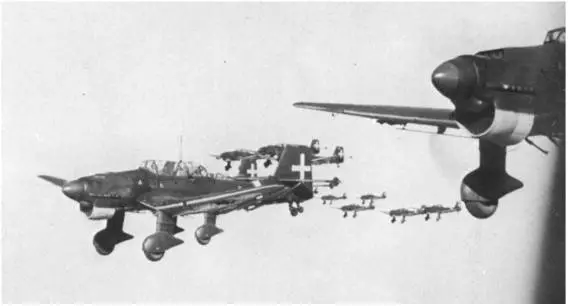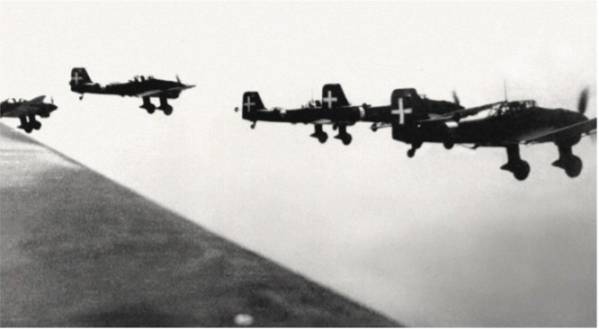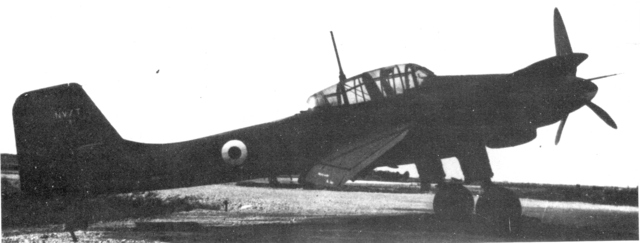The “assault” aviation
The specialization of dive-bombing found no fertile ground in Italy contrary to the United States, the United Kingdom, Japan and later Germany. However, this is partly explained by the fact that the Regia Aeronautica in the late 1920s, inspired by the theories of Colonel Amedeo Mecozzi, developed the so-called “assault aviation” concept (aviazione d’assalto) which can be identified with the concept of tactical bombing, in support of the ground forces. This way of thinking envisaged groups of single or double engine bombers flying low and attacking by surprise selected targets. It did not focus on dive-bombing but was certainly a modern concept for the times. Mecozzi’s theories were welcome by the Regia Aeronautica which, by 1934, started the development of its assault aircraft, the Breda BA 64 and BA 65, with the latter having a more relevant operational history. They were not, strictly speaking, dive-bombers but the experience in the Spanish civil war proved the worthiness of the BA 65 as a ground attack aircraft. In the late 1930s, with the BA 65 quickly ageing, the Savoia Marchetti S.M. 85 appeared, a double engine aircraft designed as a dive bomber. This proved to be one of the greatest failures of Italy’s aeronautical history. The Regia Aeronautica found itself short of a modern ground-attack aircraft capable of dive-bombing, a specialization that the experience of the Spanish civil war and the early campaigns of World War Two proved to be essential.
The arrival of the Stukas
A request for about 100 Stuka aircraft was immediately forwarded to the Luftwaffe by General Pricolo, Chief of Staff of the Italian Air Force. This request was promptly refused, given that the Germans did not intend to leave such precious and indispensable devices by removing them from their front. After a diplomatic mediation, an agreement was reached, and the 100 Stuka finally arrived in Italy.
 The Regia Aeronautica wasted no time, and immediately sent crews of Italian pilots to Graz-Thalerhof, in Austria, to begin training cycles at the Stuka school. The Italian pilots immediately proved to be very capable in the eyes of their German instructors. Already in September 1940, the 96th bombing Group (flying Stukas) was ready and operational in Sicily, and all this thanks to the incredible skill of the pilots who in a short time adapted to the new dive-bombing specialization. The pilots themselves were thrilled with the Stuka’s handling and skill characteristics, compared to the poor experiences with the terrible SM 85.
The Regia Aeronautica wasted no time, and immediately sent crews of Italian pilots to Graz-Thalerhof, in Austria, to begin training cycles at the Stuka school. The Italian pilots immediately proved to be very capable in the eyes of their German instructors. Already in September 1940, the 96th bombing Group (flying Stukas) was ready and operational in Sicily, and all this thanks to the incredible skill of the pilots who in a short time adapted to the new dive-bombing specialization. The pilots themselves were thrilled with the Stuka’s handling and skill characteristics, compared to the poor experiences with the terrible SM 85.
The first Italian Stukas were not delivered from the factory but directly from the Luftwaffe departments they had to be adapted and repainted according to the standards of the Regia Aeronautica.
The aircraft was nicknamed “Picchiatello” because the quality of the Stuka dive was well associated with the Italian term, which meant an extravagant person (a bit crazy).
Shortly after, the 97th Group was also equipped with the Ju 87 and assigned to the Greek-Albanian front.
Given the success of the training in Austria, the Regia Aeronautica established a dive-bombing training centre at Lonate Pozzolo (Northern Italy) in the attempt of being independent from Germany regarding pilot training.
In 1941, with the supply of another 50 aircraft, the 101st Group was formed, and the two previous ones were restructured.
 The new Stuka supplied to the Regia Aeronautica were the B-2 and the R-2 versions. The first was equipped with the Jumo 211D engine which reached a speed of 383km/h, armed with two 7.92mm wing machine guns and a similar rear machine gun. Under the fuselage was a 500kg bomb or a 250kg bomb and another 450kg bomb under the wings. The second model instead boasted great autonomy and was therefore excellent for reconnaissance in the open sea and allowed the assembly of Italian bombs (a 250kg bomb in the fuselage).
The new Stuka supplied to the Regia Aeronautica were the B-2 and the R-2 versions. The first was equipped with the Jumo 211D engine which reached a speed of 383km/h, armed with two 7.92mm wing machine guns and a similar rear machine gun. Under the fuselage was a 500kg bomb or a 250kg bomb and another 450kg bomb under the wings. The second model instead boasted great autonomy and was therefore excellent for reconnaissance in the open sea and allowed the assembly of Italian bombs (a 250kg bomb in the fuselage).
In 1943, the Luftwaffe made available new aircraft of the model D-3, allowing for the formation of the 103rd and 121st Group in Sardinia.
In all, 159 Junkers Ju 87 Stuka operated in the Italian Regia Aeronautica. From September 1940 until September 1943 the Stukas of the Regia Aeronautica fought relentlessly in the North African, Mediterranean and Balkan theatres, scoring successes that other ground attack aircraft in the Italian ranks could not claim. The “Picchiatelli” were heavily involved in the initial bombing campaign against Malta and, in January 1941, together with German Stukas, managed to hit the aircraft carrier HMS Illustrious. The limited number of aircraft supplied overall by Germany meant that with the progressive losses of machines, the five groups operating the Stukas received a mix of other aircraft that could cover the “assault” role but not strictly the dive-bombing. These aircraft were the Fiat G.50, the C.R. 42, the Reggiane 2002 and also a handful of Imam Ro.57.
A handful of Junkers Ju 87 survived the armistice of 1943 and flew with the markings of the “new” Regia Aeronautica, also known as ICAF (Italian co-belligerent Air Force).

Sources
AEROSTORIA. (2009). Junkers Ju-87 “Stuka” – “Picchiatello” All’italiana. Tratto da AEROSTORIA: https://www.aerostoria.com/2009/11/junkers-ju-87-stuka-picchiatello.html
Lattanzio, A. (2020). Picchiatelli su Malta: gli Stuka italiani, 1940-42. Tratto da Primo Raggio: https://ilprimoraggio.wordpress.com/2020/07/19/picchiatelli-su-malta-gli-stukas-italiani-1940-42/
Marcon, T. (1999). I tuffatori della Regia Aeronautica. Storia Militare n.66, 16-33.
Sgarlato, N. (2000). La Regia Aeronautica nella II Guerra Mondiale. Delta Editrice.